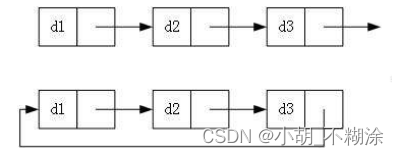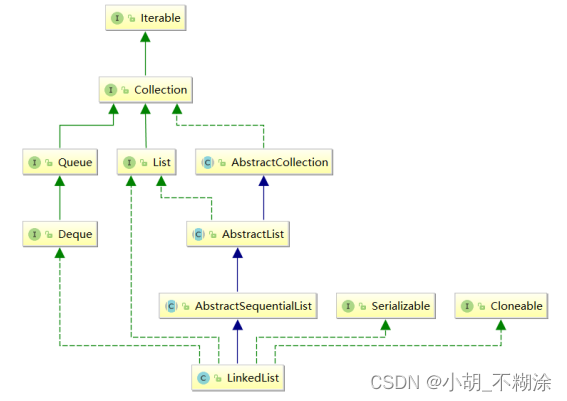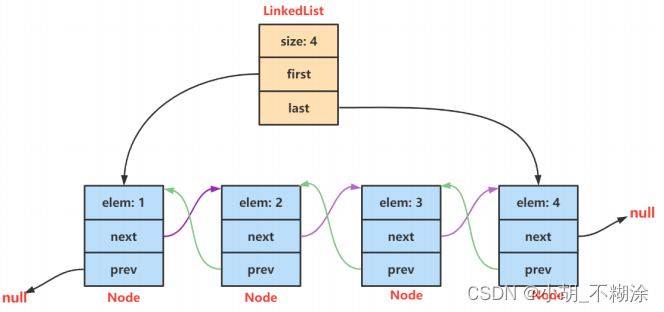⭐ 作者:小胡_不糊涂
🌱 作者主页:小胡_不糊涂的个人主页
📀 收录专栏:浅谈数据结构
💖 持续更文,关注博主少走弯路,谢谢大家支持 💖
链表
- 1. ArrayList的缺陷
- 2. 链表
- 2.1 链表的概念
- 2.2 无头单向非循环链表的模拟实现
- 2.3 无头双向链表的模拟实现
- 3. LinkedList的使用
- 3.1 什么是LinkedList
- 3.2LinkedList的使用
- 4. ArrayList和LinkedList的区别

1. ArrayList的缺陷
通过源码可以知道,ArrayList底层是使用数组来存储元素的:
public class ArrayList<E> extends AbstractList<E>implements List<E>, RandomAccess, Cloneable, java.io.Serializable{// ...// 默认容量是10private static final int DEFAULT_CAPACITY = 10;//...// 数组:用来存储元素transient Object[] elementData; // non-private to simplify nested class access// 有效元素个数private int size;public ArrayList(int initialCapacity) {if (initialCapacity > 0) {this.elementData = new Object[initialCapacity];} else if (initialCapacity == 0) {this.elementData = EMPTY_ELEMENTDATA;} else {throw new IllegalArgumentException("Illegal Capacity: "+initialCapacity);}}// ...}
由于其底层是一段连续空间,当在ArrayList任意位置插入或者删除元素时,就需要将后序元素整体往前或者往后搬移,时间复杂度为O(n),效率比较低,因此ArrayList不适合做任意位置插入和删除比较多的场景。因此:java集合中又引入了LinkedList,即链表结构。
2. 链表
2.1 链表的概念
链表是一种物理存储结构上非连续存储结构,数据元素的逻辑顺序是通过链表中的引用链接次序实现的。
链表的结构如下图所示:

- 从上图可看出,链式结构在逻辑上是连续的,但是在物理上不一定连续
- 现实中的结点一般都是从堆上申请出来的
- 从堆上申请的空间,是按照一定的策略来分配的,两次申请的空间可能连续,也可能不连续
实际中链表的结构非常多样,以下情况组合起来就有8种链表结构:
- 单向、双向链表

- 不带头、带头链表

- 循环、非循环链表

注:
- 无头单向非循环链表:结构简单,一般不会单独用来存数据。实际中更多是作为其他数据结构的子结构,如哈希桶、图的邻接表等。
- 无头双向链表:在Java的集合框架库中LinkedList底层实现就是无头双向循环链表。
2.2 无头单向非循环链表的模拟实现
public class SingleLinkedList {static class ListNode{public int val;public ListNode next;//指向当前结点的下一个结点public ListNode(int val){this.val=val;}}public ListNode head;//创建一段链表public void creatList(){ListNode node1=new ListNode(3);ListNode node2=new ListNode(7);ListNode node3=new ListNode(9);ListNode node4=new ListNode(6);node1.next=node2;node2.next=node3;node3.next=node4;this.head=node1;}//头插法public void addFirst(int data){ListNode node=new ListNode(data);//判断链表是否为空if(this.head==null){this.head=node;}else{node.next=this.head;this.head=node;}}//尾插法public void addLast(int data){ListNode node=new ListNode(data);ListNode cur=this.head;if(this.head==null){this.head=node;}else{//找到尾巴while(cur.next!=null){cur=cur.next;}cur.next=node;}}//任意位置插入,第一个数据节点为0号下标public void addIndex(int index,int data){if(index < 0 || index > size()) {throw new PosIllegality("插入元素下标异常: "+index);}if(index == 0) {addFirst(data);return;}if(index == size()) {addLast(data);return;}//找到前一个结点ListNode node=new ListNode(data);ListNode pre=this.head;while(index>1){pre=pre.next;index--;}node.next=pre.next;pre.next=node;}//查找是否包含关键字key是否在单链表当中public boolean contains(int key){ListNode cur = this.head;while (cur != null) {if(cur.val == key) {return true;}cur = cur.next;}return false;}//删除第一次出现关键字为key的节点public void remove(int key){//链表为空if(this.head==null){return;}//首结点==keyif(this.head.val==key){this.head=this.head.next;return;}//其他情况//找前驱结点ListNode pre=this.head;while(pre.next.val==key && pre.next!=null){pre=pre.next;}if(pre.next==null){System.out.println("没有你要找的值");return;}pre=pre.next.next;}//删除所有值为key的节点public void removeAllKey(int key){if(this.head == null) {return;}ListNode prev = head;ListNode cur = head.next;while (cur != null) {if(cur.val == key) {prev.next = cur.next;cur = cur.next;}else {prev = cur;cur = cur.next;}}if (head.val == key) {head = head.next;}}//得到单链表的长度public int size(){int count = 0;ListNode cur = this.head;while (cur != null) {count++;cur = cur.next;}return count;}public void clear() {ListNode cur = head;while (cur != null) {ListNode curNext = cur.next;//cur.val = null;cur.next = null;cur = curNext;}head = null;}public void display() {ListNode cur = this.head;while (cur != null) {System.out.print(cur.val+" ");cur = cur.next;}System.out.println();}
}
测试类:
public static void main(String[] args) {SingleLinkedList singleLinkedList=new SingleLinkedList();singleLinkedList.creatList();singleLinkedList.addLast(10);singleLinkedList.display();singleLinkedList.addFirst(1);singleLinkedList.display();singleLinkedList.addIndex(3,10);singleLinkedList.display();System.out.println(singleLinkedList.contains(3));singleLinkedList.remove(10);singleLinkedList.display();System.out.println(singleLinkedList.size());singleLinkedList.removeAllKey(7);singleLinkedList.display();singleLinkedList.clear();singleLinkedList.display();}
PosIllegality异常类:
public class PosIllegality extends RuntimeException{public PosIllegality(String msg) {super(msg);}
}
2.3 无头双向链表的模拟实现
public class MyLinkedList {static class ListNode {public int val;public ListNode next;public ListNode prev;public ListNode(int val) {this.val = val;}}public ListNode head;//指向头结点public ListNode last;//指向尾结点//头插法public void addFirst(int data){ListNode node = new ListNode(data);if(head == null) {head = node;last = node;}else {node.next = head;head.prev = node;head = node;}}//尾插法public void addLast(int data){ListNode node = new ListNode(data);if(head == null) {head = node;last = node;}else {last.next = node;node.prev = last;last = node;}}//任意位置插入,第一个数据节点为0号下标public void addIndex(int index,int data){int len = size();// 检查index是否合法if(index < 0 || index > len) {throw new PosIllegality("插入元素下标异常: "+index);}if(index == 0) {addFirst(data);return;}if(index == len) {addLast(data);return;}ListNode cur = findIndex(index);ListNode node = new ListNode(data);node.next = cur;cur.prev.next = node;node.prev = cur.prev;cur.prev = node;}//找当前节点前一个结点private ListNode findIndex(int index) {ListNode cur = head;while (index != 0) {cur = cur.next;index--;}return cur;}//查找是否包含关键字key是否在单链表当中public boolean contains(int key){ListNode cur = head;while (cur != null) {if(cur.val == key) {return true;}cur = cur.next;}return false;}//删除第一次出现关键字为key的节点public void remove(int key){ListNode cur = head;while (cur != null) {if(cur.val == key) {if(cur == head) {head = head.next;//head == nullif(head == null) {last = null;}else {head.prev = null;}}else {cur.prev.next = cur.next;if(cur.next == null) {last = last.prev;}else {cur.next.prev = cur.prev;}}return;}else {cur = cur.next;}}}//删除所有值为key的节点public void removeAllKey(int key){ListNode cur = head;while (cur != null) {System.out.print(cur.val+" ");cur = cur.next;}System.out.println();}//得到单链表的长度public int size(){ListNode cur = head;int count = 0;while (cur != null) {count++;cur = cur.next;}return count;}public void display(){ListNode cur = head;while (cur != null) {System.out.print(cur.val+" ");cur = cur.next;}System.out.println();}public void clear(){head = null;last = null;}
}
测试类:
public static void main(String[] args) {MyLinkedList myLinkedList = new MyLinkedList();myLinkedList.addLast(1);myLinkedList.addLast(2);myLinkedList.addLast(3);myLinkedList.addLast(4);myLinkedList.display();myLinkedList.addFirst(0);myLinkedList.display();myLinkedList.addIndex(2,9);myLinkedList.display();myLinkedList.remove(9);myLinkedList.display();myLinkedList.clear();myLinkedList.display();}
3. LinkedList的使用
3.1 什么是LinkedList
LinkedList的底层是双向链表结构,由于链表没有将元素存储在连续的空间中,元素存储在单独的节点中,然后通过引用将节点连接起来了,因此在任意位置插入或者删除元素时,不需要搬移元素,效率比较高。
在集合框架中,LinkedList也实现了List接口,具体如下:

说明:
- LinkedList实现了List接口
- LinkedList的底层使用了双向链表
- LinkedList没有实现RandomAccess接口,因此LinkedList不支持随机访问
- .LinkedList的任意位置插入和删除元素时效率比较高,时间复杂度为O(1)
- LinkedList比较适合任意位置插入的场景
3.2LinkedList的使用
LinkedList的构造:
| 方法 | 解释 |
|---|---|
| LinkedList() | 无参构造 |
| public LinkedList(Collection<? extends E> c) | 使用其他集合容器中元素构造List |
例如:
public static void main(String[] args) {// 构造一个空的LinkedListList<Integer> list1 = new LinkedList<>();List<String> list2 = new java.util.ArrayList<>();list2.add("JavaSE");list2.add("JavaWeb");list2.add("JavaEE");// 使用ArrayList构造LinkedListList<String> list3 = new LinkedList<>(list2);
}
LinkedList的其他常用方法:
| 方法 | 解释 |
|---|---|
| boolean add(E e) | 尾插 e |
| void add(int index, E element) | 将 e 插入到 index 位置 |
| boolean addAll(Collection<? extends E> c) | 尾插 c 中的元素 |
| E remove(int index) | 删除 index 位置元素 |
| boolean remove(Object o) | 删除遇到的第一个 o |
| E get(int index) | 获取下标 index 位置元素 |
| E set(int index, E element) | 将下标 index 位置元素设置为 element |
| void clear() | 清空 |
| boolean contains(Object o) | 判断 o 是否在线性表中 |
| int indexOf(Object o) | 返回第一个 o 所在下标 |
| int lastIndexOf(Object o) | 返回最后一个 o 的下标 |
| List subList(int fromIndex, int toIndex) | 截取部分 list |
使用实例:
import java.util.LinkedList;
import java.util.List;
public class Main {public static void main(String[] args) {LinkedList<Integer> list = new LinkedList<>();list.add(1); // add(elem): 表示尾插list.add(2);list.add(3);list.add(4);list.add(5);list.add(6);list.add(7);System.out.println(list.size());System.out.println(list);// 在起始位置插入0list.add(0, 0); // add(index, elem): 在index位置插入元素elemSystem.out.println(list);list.remove(); // remove(): 删除第一个元素,内部调用的是removeFirst()list.removeFirst(); // removeFirst(): 删除第一个元素list.removeLast(); // removeLast(): 删除最后元素list.remove(1); // remove(index): 删除index位置的元素System.out.println(list);// contains(elem): 检测elem元素是否存在,如果存在返回true,否则返回falseif(!list.contains(1)){list.add(0, 1);}list.add(1);System.out.println(list);System.out.println(list.indexOf(1)); // indexOf(elem): 从前往后找到第一个elem的位置System.out.println(list.lastIndexOf(1)); // lastIndexOf(elem): 从后往前找第一个1的位置int elem = list.get(0); // get(index): 获取指定位置元素list.set(0, 100); // set(index, elem): 将index位置的元素设置为elemSystem.out.println(list);// subList(from, to): 用list中[from, to)之间的元素构造一个新的LinkedList返回List<Integer> copy = list.subList(0, 3);System.out.println(list);System.out.println(copy);list.clear(); // 将list中元素清空System.out.println(list.size());}
}
LinkedList的遍历:
public static void main(String[] args) {LinkedList<Integer> list = new LinkedList<>();list.add(1); // add(elem): 表示尾插list.add(2);list.add(3);list.add(4);list.add(5);list.add(6);list.add(7);System.out.println(list.size());// foreach遍历for (int e:list) {System.out.print(e + " ");}System.out.println();// 使用迭代器遍历---正向遍历ListIterator<Integer> it = list.listIterator();while(it.hasNext()){System.out.print(it.next()+ " ");}System.out.println();// 使用反向迭代器---反向遍历ListIterator<Integer> rit = list.listIterator(list.size());while (rit.hasPrevious()){System.out.print(rit.previous() +" ");}System.out.println();}
4. ArrayList和LinkedList的区别
| 不同点 | ArrayList | LinkedList |
|---|---|---|
| 存储空间上 | 物理上一定连续 | 逻辑上连续,但物理上不一定连续 |
| 随机访问 | 支持O(1) | 不支持:O(N) |
| 头插 | 需要搬移元素,效率低O(N) | 只需修改引用的指向,时间复杂度为O(1) |
| 插入 | 空间不够时需要扩容 | 没有容量的概念 |
| 应用场景 | 元素高效存储+频繁访问 | 任意位置插入和删除频繁 |








)


顺序链表的顺序合并](http://pic.xiahunao.cn/LetCode刷题[简单题](4)顺序链表的顺序合并)






)


